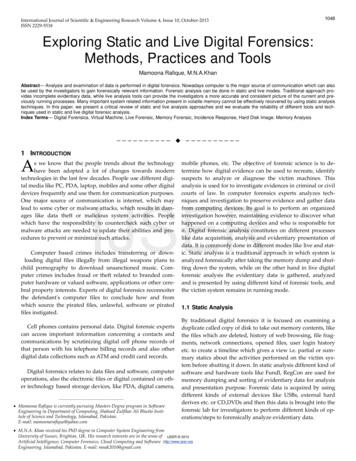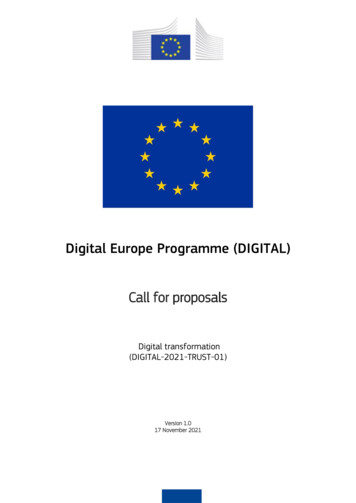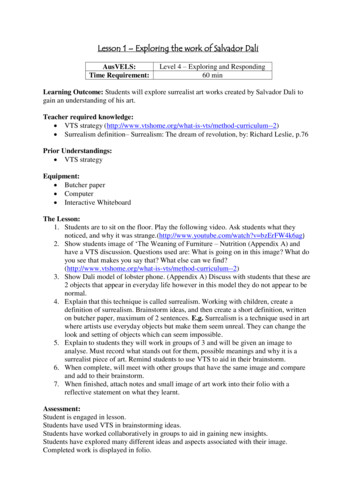
Transcription
International Journal of Scientific & Engineering Research Volume 4, Issue 10, October-2013ISSN 2229-55181048Exploring Static and Live Digital Forensics:Methods, Practices and ToolsMamoona Rafique, M.N.A.KhanAbstract— Analysis and examination of data is performed in digital forensics. Nowadays computer is the major source of communication which can alsobe used by the investigators to gain forensically relevant information. Forensic analysis can be done in static and live modes. Traditional approach provides incomplete evidentiary data, while live analysis tools can provide the investigators a more accurate and consistent picture of the current and previously running processes. Many important system related information present in volatile memory cannot be effectively recovered by using static analysistechniques. In this paper, we present a critical review of static and live analysis approaches and we evaluate the reliability of different tools and techniques used in static and live digital forensic analysis.Index Terms— Digital Forensics, Virtual Machine, Live Forensic, Memory Forensic, Incidence Response, Hard Disk Image. Memory Analysis—————————— ——————————1 INTRODUCTIONAs we know that the people trends about the technologyhave been adopted a lot of changes towards moderntechnologies in the last few decades. People use different digital media like PC, PDA, laptop, mobiles and some other digitaldevices frequently and use them for communication purposes.One major source of communication is internet, which maylead to some cyber or malware attacks, which results in damages like data theft or malicious system activities. Peoplewhich have the responsibility to countercheck such cyber ormalware attacks are needed to update their abilities and procedures to prevent or minimize such attacks.mobile phones, etc. The objective of forensic science is to determine how digital evidence can be used to recreate, identifysuspects to analyze or diagnose the victim machines. Thisanalysis is used for to investigate evidences in criminal or civilcourts of law. In computer forensics experts analyzes techniques and investigation to preserve evidence and gather datafrom computing devices. Its goal is to perform an organizedinvestigation however, maintaining evidence to discover whathappened on a computing devices and who is responsible forit. Digital forensic analysis constitutes on different processeslike data acquisition, analysis and evidentiary presentation ofdata. It is commonly done in different modes like live and static. Static analysis is a traditional approach in which system isanalyzed forensically after taking the memory dump and shutting down the system, while on the other hand in live digitalforensic analysis the evidentiary data is gathered, analyzedand is presented by using different kind of forensic tools, andthe victim system remains in running mode.IJSERComputer based crimes includes transferring or downloading digital files illegally from illegal weapons plans tochild pornography to download unsanctioned music. Computer crimes includes fraud or theft related to branded computer hardware or valued software, applications or other cerebral property interests. Experts of digital forensics reconnoiterthe defendant's computer files to conclude how and fromwhich source the pirated files, unlawful, software or piratedfiles instigated.Cell phones contains personal data. Digital forensic expertscan access important information concerning a contacts andcommunications by scrutinizing digital cell phone records ofthat person with his telephone billing records and also otherdigital data collections such as ATM and credit card records.Digital forensics relates to data files and software, computeroperations, also the electronic files or digital contained on other technology based storage devices, like PDA, digital ��— Mamoona Rafique is currently pursuing Masters Degree program in SoftwareEngineering in Department of Computing, Shaheed Zulfikar Ali Bhutto Institute of Science and Technology, Islamabad, Pakistan.E-mail: mamoonarafique@yahoo.com1.1 Static AnalysisBy traditional digital forensics it is focused on examining aduplicate called copy of disk to take out memory contents, likethe files which are deleted, history of web browsing, file fragments, network connections, opened files, user login historyetc. to create a timeline which gives a view i.e. partial or summary statics about the activities performed on the victim system before shutting it down. In static analysis different kind ofsoftware and hardware tools like Fundl, RegCon are used formemory dumping and sorting of evidentiary data for analysisand presentation purpose. Forensic data is acquired by usingdifferent kinds of external devices like USBs, external hardderives etc. or CD,DVDs and then this data is brought into theforensic lab for investigators to perform different kinds of operations/steps to forensically analyze evidentiary data. M.N.A. Khan received his PhD degree in Computer System Engineering fromUniversity of Sussex, Brighton, UK. His research interests are in the areas of IJSER 2013Artificial Intelligence, Computer Forensics, Cloud Computing and Software http://www.ijser.orgEngineering. Islamabad, Pakistan. E-mail: mnak2010@gmail.com
International Journal of Scientific & Engineering Research Volume 4, Issue 10, October-2013ISSN 2229-551810491.2 Live Analysis1.4 Key challengesNew challenges are presented by the field of live forensicanalysis which includes non-interactive analysis and datasnapshots, which requires the progress of fresh data modelsand the designs of user interface.In live digital forensics, information is gathered, analyzedand reports are generated, while the compromised systemremains functional, the tools used for live digital forensicanalysis can provide very clear pictures of knowledge such asmemory dumps, running processes, open network connections and unencrypted versions of encrypted files, while suchmemory contents cannot be acquired properly in static analysis. It means that the live analysis provides the consistencyand integrity of forensic data. This gathered information canbe used in different ways to produce forensic evidence or torepresent the forensically activities and actions performed byuser directly or by remote login on that compromised system.The field of live forensic analysis presents new challenges including data snapshots and non-interactive analysis, requiringthe development of new data models and user interface designs. When tools are loaded in the RAM to gather and analyze the victim system, some times these tools also affect thememory contents which can misleads the analysis results. Thiscan be overcome by using the appropriate tools and procedures for live digital forensic analysis. Sometimes the requirement is to perform analysis without affecting the functionality of the system so that the entire functionality performed by that system should not be disturbed during performing the digital analysis.1.3 Live vs. Static AnalysisStatic analysis is the traditional forensic investigations that areexecuted on such data which is at rest, for instance, the different contents of a hard drive. Investigators shut down the different computer systems due to their confiscation of dreadthat the digital time bombs could affect and remove the data.IJSERIn present and recent years, there is given more stress toperform study on live systems and it is increased. First reasonis: Against different computer systems maximum recent attacks leaves nothing in matter of evidence and trace on thehard drive of computer. The memory of computer is only exploited by these attacks. Another factor of this cause is themore utilization of cryptographic storage, keys copy to decrypt the computer's memory storage, causes the informationto be lost by turning off the system.Different areas of live and static forensics are discussed inthis paper, which includes the different kinds of informationwhich can be collected, and the way how evidence could bestudied and the way how it works in conjunction with different traditional and old methods, moreover it also satisfies forensic requirements. We have discussed in details the techniques of static disk analysis, how to gathering information ona live machine, which live state data and information is all andall accessible on computer.The goal of this paper is to discuss various techniques usedin live and static digital analysis. The rest of the paper is organized as follows. Section II describes literature review. SectionIII describes the critical review and section IV consists of conclusion and future work in next section.IJSER 2013http://www.ijser.org
International Journal of Scientific & Engineering Research Volume 4, Issue 10, October-2013ISSN 2229-551810501.5 Table of ToolsSr.NoTool NameOp SysPurpose/Description1.Registry ReconWindowsThis tool is used to rebuild the registries of Windows fromany place of a hard drive and further it is parsed for theanalysis in depth.StaticSIFT is used to perform digital forensic analysis on differentoperating .SIFT (SANS Investigative Forensics Toolkit)UbuntuEnCaseWindowsDigital Forensics FrameworkWindows/ Linux/ Mac OSEPRB (Elcomsoft Password Recovery Bundle)PTK Forensics ( ProgrammersToolkit)FTK (Forensic Toolkit)The Coroner's ToolkitThe Sleuth KitWindowsLAMPWindows21.22.It is GUI based framework for static and live analysis.This tool is used to perform digital analysis and indexingthe evidentiary data.It is a command line user interface tool to perform forensicanalysis on Unix systems.Toolkit provides GUI and command line interface to perform digital forensic analysis in Unix and windows.IJSERUnixUnix/WindowsCOFEE ( Computer online forensicevidence extractor)WindowsOCFA (Open Computer ForensicsArchitecture)LinuxOS ForensicsWindowsSafeBackWindowsForensic AssistantWindowsX-Way ForensicsWindowsCAINE (Computer Aided investigative environment)Linuxbulk extractorWindows, LinuxIRCR (Incident Response Collection Report)WindowsIntellaWindowsCMAT(Compile Memory AnalysisTool)WindowsWFT (Window Forensic Toolkit)Windows19.20.This tool is used to gather and analyze memory dump indigital forensic investigation in static modeDuring the live and static analysis, DFF is utilized as a development platform and digital investigation tool.This toolkit is used to perform digital analysis on encryptedsystem, password recovery and data decryption.COFEE is used to extract and analyze forensic data lively.It is a command line interface for distributed computer forensics and it is used to analyze digital media. It is mostlyused in digital forensic labs.This tool is used to perform analysis on E-mail, Files, Imagesand web browsers.This tool is used for evidence collection, analysis and forcreating backup of evidentiary data in digital media.It is used to analyze the activities performed by user on internet like emails, docs and IM and web browsers.This tool is used for the general purpose on Win Hex editorused to perform static and live analysis.Command line user interface used for distributed and standalone computer forensics.For the extraction of phone numbers, email addresses, URLsand the other objects which are identified.Collects live forensics information from the command history, computer, network connection, current processes,opened ports, registry startup information and event logsfrom system.It is used to process and investigate Email, digital data andCellphones.It extracts information from the memory dump and alsoexposes malware.Toolkit used to analyze the memory, system information,file/directory timestamp, port number, user information,IJSER hBothLiveLiveLiveLiveLive
International Journal of Scientific & Engineering Research Volume 4, Issue 10, October-2013ISSN 2229-551823.ResponderWindowsFRED(First Responder’s EvidenceDisk)WindowsMemoryzeWindowsWindows SCOPEWindowsSecond LookLinux28.Volatility Framework29.30.VolafoxVolatility systemsMac OSLiveWireWindows31.Network Miner32.33.Net ndows/Mac/LinuxWindows24.25.26.27.Tcp flowToolkit used for the extraction of items from RAM.It extracts digital items from volatile memory.The tool used to obtain memory dump and it extracts harddrive data of the network computers and servers.IJSER34.WireShark35.Evidence Eliminator36.NetSleuth37.DECAF(Detect and EliminateComputer Assisted Forensic)HashKeeper38.and current process and network configurations for digitalforensics analysis.For the robust analysis of Mal ware which includes the disassembly on low level and this tool is also used for the runtime behavior tracing.Collects live and volatile forensics information, currentprocesses, opened port number, current logged on users,hidden streams, network configuration, and the files in C:and D: drives.It acquires and analyze RAM images which includes thepage file on live systems.Provides memory acquisition and access to locked computers.It preserve evidence in volatile memory and also uncovermalware.WindowsWindowsWindowsIt extracts files, images and other metadata from PCAP files.1051LiveLiveLiveLiveLiveLiveLiveLiveLiveIt is used to analyze transitory informationThis tool is used for breaking down of flows e.g. sessions ascommon entities.BothLiveIt is used to captures and analyze packets.BothIt is anti-forensics software which surely deletes the filesand claims it as its main job.It can identify and fingerprints network hosts and devicesfrom pcap files which can be captured from Ethernet.The user defined actions can be executed automatically using this tool.Database application used for storing file hash signatures.LiveLiveLiveStatichelp reduce the cost of response and improve quality of evidence.2 LITERATURE REVIEW2.1 Review StageCohen et al. [1] proposed a rapid response framework namedas GRR (Gradual Release of Responsibility) to decrease theinvestigative effort required per machine. GRR progressesisolated live forensics, by engage in auditing, secrecy issues,and accessible. It delivers a protected and accessible platformto enable forensic analysis solutions. GRR supports automatedanalysis for a large enterprise data set by executing complexqueries in shorter spam of time; thus enhancing the investigative capacity. GRR impose enterprise procedures as it is capable to scan corporate digital assets instantaneously. GRR canMrdovic et al. [2] states that live analysis a running systemcan be used to obtain volatile data to understand of events thathad occurred in the past. Running systems are in-capable ofbeing reverse and change their state by making collected evidence invalid. Volatile memory dump can also be used for theanalysis of the live data in offline mode. Data can be usedfrom the memory dump; static data creates the virtual machine that can provide good picture of live system when dumpwas taken. With virtual machine investigator makes interactive sessions without violating evidence integrity. The considered combination of live digital forensic and static analysisoffers new possibilities in the virtual environment. In liveIJSER 2013http://www.ijser.org
International Journal of Scientific & Engineering Research Volume 4, Issue 10, October-2013ISSN 2229-5518analysis, system is hibernated before carrying out any examination. It is the best way in order to save volatile memory andstate of system and it does not need the change and additiontools in system state. When the system is hibernated, secondary storage image is created and can be used for analysis.Chan et al. [3] state that recent autopsy cyber-forensic techniques may cause disturbance to the evidence gatheringprocess by breaking active network connections and encodeddisks. Modern live forensic analysis tools can preserve activestate. This proposed framework provides investigators to testthe running system without changing its state. It saves therunning system state and allows currently working processeslike open files, encrypted file system. The proposed framework named as Forenscope can detect secret rootkits, defuseextortions and thus speeds up the investigation process.Hay et al. [4] discussed approaches, the techniques and toolsof the live analysis on virtual and real environment. As computer technologies become pervasive, they need supporting digital forensics tools and techniques for efficiently analyzing related system behavior. To investigate the challenges andthe progress for the live analysis it is considered very necessary to realize traditional approach of the digital forensics. Itimplicates the system halting and creating a valid copy of thedata for analysis of the storage media. The Static tool searchesthe storage media for discovering digital evidence. Static analysis results in an incomplete picture of the event. The limitingfactors in static analysis pertain to processes shutdown, encrypted data and absence of memory content details.1052Khangar et al. [6] states that Static analysis is the fundamental approach of digital forensics. It consists of study of datastored on storage media i.e. permanent. When static analysisexamined a system, it does not provide complete scenario ofevent. Hence a VM created from the static data helps in locating evidence. VM facilitates a very simpler way of investigation. Virtualization technology usage in commercial area isgrowing continuously. So virtual environment needs to beexamined itself instead of using virtual environment. Datarecovery through using VM files is vertical part. Data recoveryis possible in virtual environment but what will be recoveredis not predictable. In present era use of virtualization in everyorganization is very common. Investigation can be donethrough without violating data collection as evidence sincevirtual desktop can be made as forensic platform. Howevervirtual environment investigation is simpler than the physicalinvestigation.Jones [7] proposed a method to improve the integrity andthe analytical value of data which is gathered for forensicanalysis, a comparison is also provided to identify the limitation in current live forensic techniques. Computer forensicprocesses have four stages: Collection, analysis, presentationand examination. In Collection stage there is the involvementof location, appropriation and the obtaining data in the forensic manner. Manual and computerized techniques both areinvolves in examination stage for data identification and extraction. Analysis process uses the applicable data to verifywhich action has been executed by using the resources ofcomputer. Lastly, reporting shows forensic examiner has gathered information and it will generally take the form of written report. As we see that the dead methodology has full copyof all the data on the storage device i.e. hard disk. This is beneficial and more informative, which is not in hard disk, arepresent in computers. Computer practitioners have got theresponse of criminals due to their successes of. For instancethere is lot of criminals who use the technique of encryptionand undoubtedly they have the accurate copy of encrypted filewhich is unused by forensic examiner. These files can beopened with Best Crypt program which decrypt data mountfile. Such file system can be approached as like another filesystem when key has been provided to the program. Both encryption and decryption are transparent. As this data is volatile and can be lost with turning off the computers. And otherdata like decrypted keys which are used for encrypted filescan be preserved also in the volatile memory.IJSERWhereas the analysis which is done live collects the datafrom the running system and deals with many inadequacies ofthe static analysis. There is lot of ways for the live analysis ofphysical machines during the use of imported utilities, standard user interface and modified system and in the case ofVM, the techniques includes interactive logging/replay andthe live analysis. Every technique consists of its own advantages and disadvantages. They can also contribute to the liveanalysis evolution.Wang et al. [5] considered a computer live forensics’ modelon the basis of physical memory analysis. This model can effectively address lot of challenges which are being faced bylive forensics. Authors discussed several issues of credibility oflive forensics. Firstly, live forensics calculates the possible creditability which is based on the model of memory analysis,enables validation of live analysis and minimizes impact oncollected evidence. Outcomes of live forensics on the evidence,which has calculated, consists of the chance of covering keytrace by forensic toolkit and the affects region in digital evidence, authenticity, integrity, verifying consistency rules, repeatability, applicability and fault tolerance.Adelstine [8] highlights that information can be extractedfrom a victim system and this information can be used as evidence in live digital forensic analysis. In dead analysis a staticdisk image is examined by Digital Forensics and a bit streamcopy of a disk is generated when compromised system is powered off. While in live forensics data is collected when victimIJSER 2013http://www.ijser.org
International Journal of Scientific & Engineering Research Volume 4, Issue 10, October-2013ISSN 2229-5518system is alive. Forensic data collected through live systemcan give proof which is not obtainable in astatic disk image.Different constraints are used to operate live forensics mainly,the proof collected exposes a dynamic system’s snapshotwhich later on impossible to be reproduced on later dates.Information which is provided by the live system gives a context for disk’s data e.g. network connections, runningprocesses, physical memory and process memory and the majority of state items like logged on users, caches and systemload, while these are unavailable when system is powered off.In live analysis some hidden processes like rootkits are unavailable but are available in dead analysis. After the collectionphase forensic tools are applied on the evidentiary data to perform analysis. Collection of forensic relevant data assists theforensic investigators which produces efficient results andfaster response in live digital forensic analysis. When tools areloaded in the RAM to gather and analyze the victim system,these tools some time also effects the memory contents whichcan misleads the analysis results. This can be overcome byusing the appropriate tool and procedures for live digital forensic analysis.1053tem. This file is static and cannot be changed. The importanceof boot is that it hide the information from hackers and provide the security. If the values of file is changes from its defaultvalue then there will no booting of the system. This file contain the information like size, clusters and MFT. So for analystto perform analysis they should consider one thing very important, that there is a difference between boot sector andbackup sector. The major technique used for the analysis isMD5, in which checksum differences reflect that there aresome entries that are hidden from the analysis tool.Casey et al. [11] describes that by using FDE (full disk encryption) can be considerably block the digital investigations,which conducts to stopping the access to every digital evidence. Quitting use of evidential system cannot be a techniqueused satisfactorily, during have the deal with volume encryption or FDE and all the data in results on the device is out-ofthe-way for forensic examination. Such challenges can be addressed, for that there will be the requirement for further effective competencies to identify and conserve encryption before plug pulling. Furthermore, in order to provide the betteropportunity to digital investigators to obtain the decrypteddata in working field, search warrants’ preparation is neededby prosecutors with FDE. FDE has disadvantaged earlier investigations, offers directions for assembling the items at thescene of crime that might be beneficial for dealing the data(encrypted), also to perform crime scene forensic acquisitionsof live digital forensic systems. Such sort of procedures increases the probabilities of obtaining digital evidence in unencrypted situation or state or detaining a passphrase or encryption key. For drafting, there are some applicants also and performing a search warrants in order to deal with FDE.IJSERHay et al. [9] Hay et al. [9] shows Xen and virtual introspection (VI) which is termed as VIX tools which is used to putfocus on the assessment and test of the computer systems.Here the most vital properties of system akin to acquisition ofhard disk and its analysis are available only in volatile memory which can’t be recovered by techniques of static analysis.Another approach, in which there is the live study and examination of target systems to expose such volatile data, offerslarge and considerable risks and challenges to forensic investigators because the techniques of investigation are normallyintrusive and it can directly or indirectly affect the systemwhich is under the observation. By the technique of staticanalysis, such memory cannot be recovered affectively. As thisis the real straight forward approach: failure of the defense ofsystem can be observed critically using this ability. Its seriousability to determine how the defense of a system failed and towhat extent the affected systems have already been compromised. Using particularly this knowledge, attacks of future canbe lessened. Hence, digital forensics’ techniques and methodscan present such knowledge. Unluckily, due to the introduction of virtualization technologies, digital investigations hasbecome now more complicated and there is more unclearnessin the boundaries of the target system.Mohamad et al. [12] file carving recovers files with unobtainable file system metadata from data storage and in forensics investigation it is very worthwhile. Though, previouscarver generation file such as Scalpel and Foremost considernon-fragmented files. Author suggested automatic image andthumbnail carving tool which is known as my Karve. In digitalforensics investigation my Karve is worthwhile and evidentialinformation presentation which carve adjoining and fragmented images caused by garbage. myKarve deal with fragmentation and thumbnail issues and it is designed on a newarchitecture. The thumbnail carving tool tests with the imagesget from the Internet. myKarve is effective thumbnail carverand automated image compared to the inventive Scalpel.Alazab et al. [10] states that MTF (Master file table) is majorpart of the NT file system because it contains all the detail ofthe files and folders. It helps the investigators to fetch the information about the structure and the working of NTFS. MTFcontain metadata file which is very important and tells the filesystem details. The metadata file contain system bootable file( boot) file. This file is responsible for the booting of the sysIJSER 2013http://www.ijser.org
1054International Journal of Scientific & Engineering Research Volume 4, Issue 10, October-2013ISSN 2229-55183 CRITICAL REVIEW3.1 TableRef[1]AreaAuditing and secrecy issuesplatform.[2]Performing static and livedigital analysis on virtualenvironment[3]Live forensic techniques andevidence preservations[4]Challenges of Live analysis[5]Forensics analysis of physicalmemory[6]Investigating virtual machines in digital analysis[7]A framework to improve liveforensic methodologies[8]Digital evidence collectionMeritsIt provides cross-platform support for Linux,Mac OS X and Windows clients (agents), andvolatility integration for memory analysis. Itprovides scriptable! I Python console accessand basic system time lining features. It alsosupport for asynchronous flows and detailedmonitoring of client CPU, memory, I/O usage.It allows static and live combinations of memory dump and highlights rootkits when system is running.This framework tested on run time processwhich don’t affect any of the result andprocess. And it can perform analysis not morethan 15 seconds whereas using 125 KB ofmemory.It assists reconfiguring the system to preventattacks. There are enriched opportunities indigital forensic live analysis arena for R&Daccording to the both physical as well as virtual machines. Replay ability demonstrates ata pace i.e. arbitrary without giving any alert touser of aimed VM.Computer live forensics makes calculatingcredibility possible. Enables live computerevidence validation. Tool impact on system’sdata minimized. Consistency verifying technically prevents fake records of investigations.Data recovery is possible by interacting withVM file system. Should have well knownstructure to handle data.It freezes current state of machine and thenduring data acquisition, there is no need tomake modifications. It gives a guarantee thatproduction of image by this frame work willnot have been slurred and kills all those procedures and processes which are not considered important for the system.Provides the evidence which is not all available in the static memory dump.LimitationsThe main limitation of the system is that it requires client server environment and is not feasible for standalone machines.It works on virtual environment which sometimes unable to trace the malware, as some malwares has the property to hide themselves onvirtual machine.It requires transpire as users using more networkservices, privacy software and non-magneticstorage technologies.There are no repeatable operations. There is lackof user credentials by the investigators for thesystem which is targeted. System becomes untrustworthy due to alteration of memory. It doesnot address system integrity completely. Inconsistency leads to some problems like attack detection and automate the
Digital forensics relates to data files and software, computer operations, also the electronic files or digital contained on oth-er technology based storage devices, like PDA, digital camera, mobile phones, etc. The objective of forensic science is to de-termine how di










